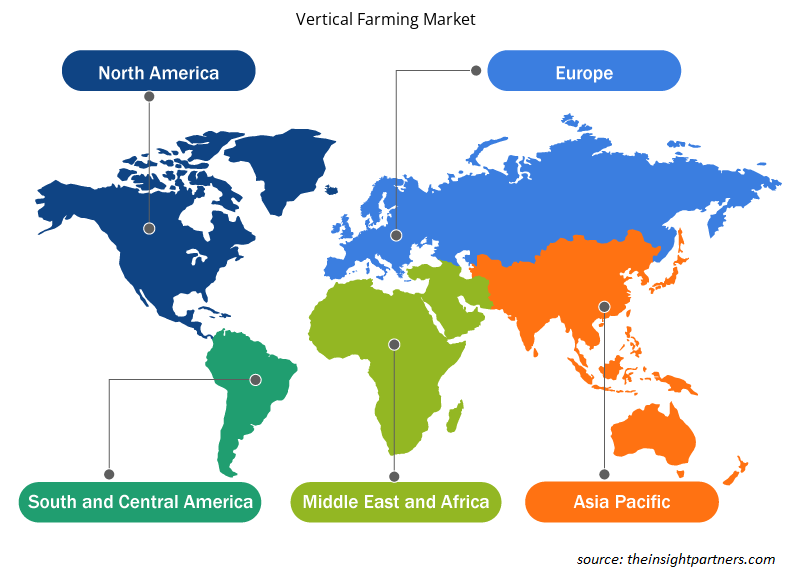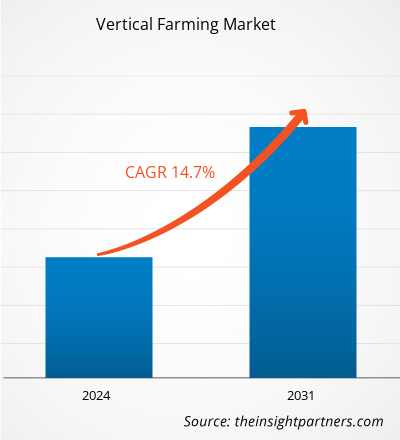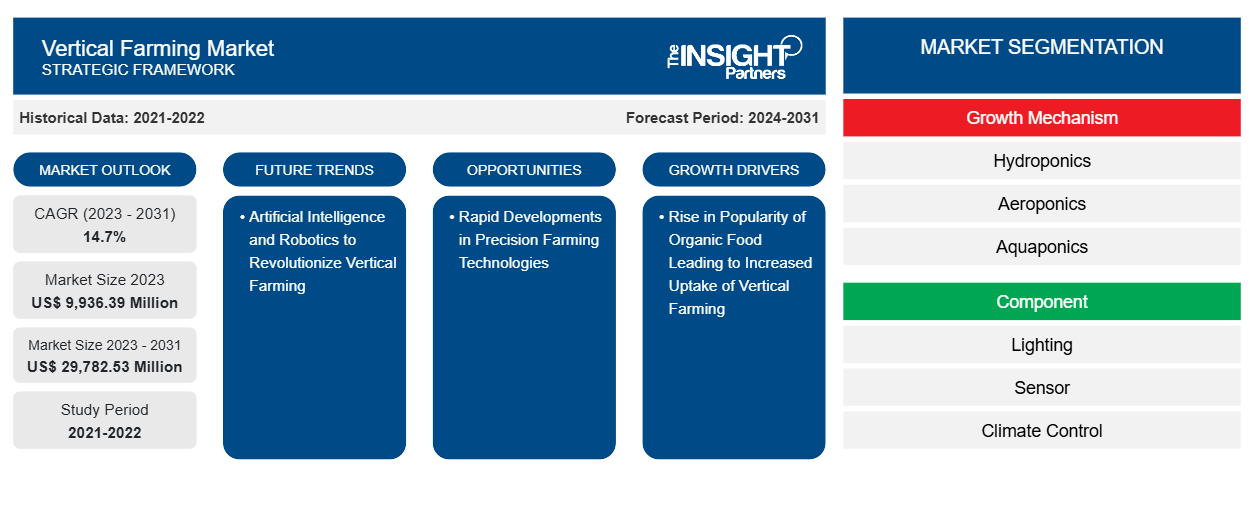수직 농업 시장 규모는 2023년 9,936.39백만 달러에서 2031년까지 29,782.53백만 달러로 성장할 것으로 예상됩니다. 이 시장은 2023~2031년 동안 14.7%의 CAGR을 기록할 것으로 예상됩니다. 유기농 식품에 대한 수요 증가와 정밀 농업에 대한 강조 증가는 시장의 주요 추세로 남을 가능성이 높습니다.
수직 농업 시장 분석
인구 증가와 건강한 음식에 대한 소비자 인식은 수직 농업의 주요 원동력으로 작용하고 있습니다. 스마트하고 정밀한 농업에 대한 우려가 커지면서 전 세계적으로 수직 농업 시장에 긍정적인 영향을 미치고 있습니다. 인지 부족과 높은 유지 관리 비용은 시장 성장을 방해할 수 있는 몇 가지 이유입니다. 그러나 스마트 농업 기술에 대한 정부 이니셔티브가 확대되면서 예측 기간 동안 수직 농업의 성장이 촉진될 것으로 예상됩니다.
수직 농업 시장 개요
수직 농업은 작물을 수직으로 재배하거나 쌓는 과정입니다. 전체 과정은 수경 재배, 에어로포닉스, 아쿠아포닉스 와 같은 방법을 활용하여 통제된 환경에서 운영됩니다 . 이 과정은 기존 농업 기술보다 훨씬 적은 양의 물에서 작물을 재배하는 데 도움이 됩니다. 그 외에도 수직 농업은 작물을 재배하는 데 필요한 살충제 및 기타 독성 살충제도 줄입니다. 확대되는 도시화와 인구 증가는 식량 수요를 증가시키고 있으며, 이는 시장의 원동력으로 작용하고 있습니다. 제약 회사도 의약품을 위한 생물의학 식물을 재배하기 위해 실내 수직 농업에 집중하고 있으며, 이는 또한 전 세계 시장의 주요 긍정적인 추세 중 하나입니다.
귀하의 요구 사항에 맞게 이 보고서를 사용자 정의하세요
이 보고서의 일부 또는 국가 수준 분석, Excel 데이터 팩을 포함하여 모든 보고서에 대한 사용자 정의를 무료로 받을 수 있으며 신생 기업 및 대학을 위한 훌륭한 혜택과 할인 혜택을 이용할 수 있습니다.
-
이 보고서의 주요 시장 동향을 알아보세요.이 무료 샘플에는 시장 동향부터 추정 및 예측까지 다양한 데이터 분석이 포함됩니다.
수직 농업 시장 동인 및 기회
유기농 식품 인기 상승으로 시장 호조세
건강에 대한 의식이 높아지고 건강한 식품 에 대한 성향이 수직 농업 시장의 주요 원동력으로 작용하고 있습니다. 소비자는 과일, 채소, 곡물과 같은 유기농 작물을 선호하고 소비하는 데 관심을 보입니다. 건강에 대한 인식이 높아지는 것은 해로운 인공 물질이나 화학 물질이 없는 식품에 대한 소비자 수요가 증가하는 주요 이유 중 하나입니다. 화학적으로 처리된 작물이나 채소의 소비와 관련된 건강 위험 증가는 유기농 식품의 주요 원동력으로 작용하여 수직 농업에 대한 수요를 촉진하고 있습니다. 일년 내내 비전통적이고 유기농으로 재배된 식품에 대한 수요가 증가하는 것도 전 세계 시장에 긍정적인 영향을 미치고 있습니다.
수직 농장을 혁신할 인공지능과 로봇공학
프로세스 자동화 및 로봇 기술 통합 측면에서 증가하는 기술 발전은 수직 농업 시장에 큰 기회를 제공할 것으로 예상됩니다. 시장에서 운영되는 농업 농장은 식물의 유지 관리 및 관리를 보다 체계적이고 간소화된 방식으로 발전시키기 위해 인공 지능 기술을 도입하기 위한 연구 및 개발 활동에 더 집중하고 있습니다. 또한 일부 회사는 인간의 개입을 줄이고 시간 효율성을 높이기 위해 수직 농업 산업에 로봇을 도입하는 데 집중하고 있으며, 이는 또한 전 세계적으로 수직 농업 시장의 성장을 촉진할 것으로 예상됩니다.
수직 농업 시장 보고서 세분화 분석
수직 농업 시장 분석에 기여한 주요 세그먼트는 제품 성장 메커니즘과 구성 요소입니다.
- 성장 메커니즘에 따라 시장은 수경재배, 에어로포닉스, 아쿠아포닉스로 나뉩니다. 수경재배 부문은 2023년에 더 큰 시장 점유율을 차지했습니다.
- 구성 요소별로 시장은 조명, 센서, 기후 제어, 관개 구성 요소, 건축 자재 등으로 세분화됩니다. 조명 부문은 2023년에 시장에서 상당한 점유율을 차지했습니다.
지역별 수직 농업 시장 점유율 분석
수직 농업 시장 보고서의 지리적 범위는 주로 북미, 아시아 태평양, 유럽, 중동 및 아프리카, 남미 및 중앙 아메리카의 5개 지역으로 나뉩니다.
북미가 시장을 선도하고 있습니다. 식량 생산을 촉진하고 일년 내내 제철 과일과 채소의 가용성을 높이기 위한 첨단 기술에 대한 높은 투자가 북미 지역의 수직 농업에 대한 수요를 견인하고 있습니다. 비전통적이고 유기적으로 재배된 과일, 곡물 및 채소에 대한 수요 증가도 북미 시장의 진화를 촉진하고 있습니다. 온도 변화와 변화하는 기상 조건은 다양한 국가에서 채소와 과일의 성장을 방해하는 주요 요인입니다. 극한의 기온 조건을 가진 국가는 북미에서 수직 농업에 대한 수요를 촉진하고 있습니다. 공간 제약은 또한 수직 농업 기술 채택이 증가하는 주요 이유 중 하나인 적층형 농업으로 충족됩니다. 농업 부문에서 자동화 채택이 증가하고 로봇 기술이 증가하는 것도 이 지역의 수직 농업 시장에 긍정적인 영향을 미치고 있습니다. 미국은 북미에서 수직 농업 시장을 선도하고 있습니다.
수직 농업 시장 지역 통찰력
Insight Partners의 분석가들은 예측 기간 동안 수직 농업 시장에 영향을 미치는 지역적 추세와 요인을 철저히 설명했습니다. 이 섹션에서는 북미, 유럽, 아시아 태평양, 중동 및 아프리카, 남미 및 중미의 수직 농업 시장 세그먼트와 지리에 대해서도 설명합니다.

- 수직 농업 시장을 위한 지역별 특정 데이터 얻기
수직 농업 시장 보고서 범위
| 보고서 속성 | 세부 |
|---|---|
| 2023년 시장 규모 | 9,936.39백만 달러 |
| 2031년까지 시장 규모 | 29,782.53백만 달러 |
| 글로벌 CAGR (2023-2031) | 14.7% |
| 역사적 데이터 | 2021-2022 |
| 예측 기간 | 2024-2031 |
| 다루는 세그먼트 |
성장 메커니즘에 의해
|
| 포함된 지역 및 국가 |
북아메리카
|
| 시장 선도 기업 및 주요 회사 프로필 |
|
수직 농업 시장 참여자 밀도: 비즈니스 역학에 미치는 영향 이해
수직 농업 시장 시장은 소비자 선호도의 변화, 기술 발전, 제품의 이점에 대한 인식 증가와 같은 요인으로 인해 최종 사용자 수요가 증가함에 따라 빠르게 성장하고 있습니다. 수요가 증가함에 따라 기업은 제품을 확장하고, 소비자의 요구를 충족하기 위해 혁신하고, 새로운 트렌드를 활용하여 시장 성장을 더욱 촉진하고 있습니다.
시장 참여자 밀도는 특정 시장이나 산업 내에서 운영되는 회사나 기업의 분포를 말합니다. 주어진 시장 공간에 얼마나 많은 경쟁자(시장 참여자)가 존재하는지 그 규모나 전체 시장 가치에 비해 나타냅니다.
수직 농업 시장에서 운영되는 주요 회사는 다음과 같습니다.
- 에덴그린테크놀로지
- 엘리베이트 팜스 주식회사
- 아이팜
- 오스람 GmbH
- 플렌티 언리미티드 주식회사
- 스카이 그린스
면책 조항 : 위에 나열된 회사는 어떤 특별한 순서에 따라 순위가 매겨지지 않았습니다.

- 수직 농업 시장의 주요 기업 개요를 알아보세요
수직 농업 시장 뉴스 및 최근 개발
수직 농업 시장은 1차 및 2차 연구 이후의 질적, 양적 데이터를 수집하여 평가합니다. 여기에는 중요한 기업 간행물, 협회 데이터 및 데이터베이스가 포함됩니다. 수직 농업 시장의 몇 가지 개발 사항은 다음과 같습니다.
- 에덴 그린 테크놀로지는 수직 농장-온실 콤보에 1,200만 달러를 확보했습니다. (출처: 에덴 그린 테크놀로지, 보도자료, 2024년 3월)
- Elevate Farms Inc.는 미국과 유럽 모두에서 수직 농사 잎이 많은 채소의 영역을 확장한다고 발표했습니다. (출처: Elevate Farms Inc., 보도자료, 2024년 2월)
수직 농업 시장 보고서 범위 및 제공물
"수직 농업 시장 규모 및 예측(2021-2031)" 보고서는 아래 영역을 포괄하는 시장에 대한 자세한 분석을 제공합니다.
- 범위에 포함된 모든 주요 시장 세그먼트에 대한 글로벌, 지역 및 국가 수준의 수직 농업 시장 규모 및 예측
- 수직 농업 시장 동향과 동인, 제약 및 주요 기회와 같은 시장 역학
- 자세한 PEST 및 SWOT 분석
- 주요 시장 동향, 글로벌 및 지역 프레임워크, 주요 업체, 규정 및 최근 시장 개발 사항을 포괄하는 수직 농업 시장 분석
- 시장 집중도, 히트맵 분석, 유명 업체 및 수직 농업 시장의 최근 개발 사항을 포함하는 산업 환경 및 경쟁 분석
- 자세한 회사 프로필
- 과거 분석(2년), 기준 연도, CAGR을 포함한 예측(7년)
- PEST 및 SWOT 분석
- 시장 규모 가치/거래량 - 글로벌, 지역, 국가
- 산업 및 경쟁 환경
- Excel 데이터세트
최근 보고서
사용 후기
구매 이유
- 정보에 기반한 의사 결정
- 시장 역학 이해
- 경쟁 분석
- 고객 인사이트
- 시장 예측
- 위험 완화
- 전략 기획
- 투자 타당성 분석
- 신흥 시장 파악
- 마케팅 전략 강화
- 운영 효율성 향상
- 규제 동향에 발맞춰 대응























 무료 샘플 받기 - 수직 농업 시장
무료 샘플 받기 - 수직 농업 시장